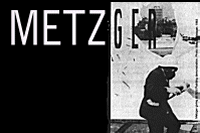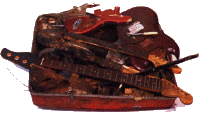Intimate Auto-Destruction | |
 | It's clear that one of the most tiresome irritants of large galleries and shows is the inherent lack of intimacy: the impossibility of experiencing any real contact with the work. How can you hope to experience any real emotion outside of hyped awe in, to take an obvious example, the recent Royal Academy Monet show, when the seething mass of the populace inhibits even the physical view? One of the delights, therefore, of small galleries (particularly those in smaller cities) is that the intimacy with the art is kept largely intact. The scale also helps to focus the mind, something which is particularly important when experiencing work of a more conceptual nature, as in the current Gustav Metzger show at the Spacex Gallery, Exeter. Metzger, most (in)famous for his auto-destructive art theories so beloved of the likes of the Who's Pete Towshend, citing Metzger as primary influence for his own auto-destructive performances in the context of Rock, is a diminutive figure with a calm intensity. Tellingly, given the nature of his work in confronting issues of Art ownership and concepts of Art as industrial artefact, he is also open and available for dialogue: in my visits to the show during the mid-week opening hours, he was noticeably visible, eager to discuss his work with the public and taking informal tutorial sessions with students keen to show and discuss with him their and his work. Metzger is no unimportant figure in the Art world, and it is hard to imagine such intimacy being possible in a larger gallery, or in a larger city. |
 Townshend's Autodestructive Remains |
The work on show investigates something of Metzger's previous work, showing the contextual progression of his ideas and responses to Art, through to pieces which show his current concerns. The most 'historical' section displays examples of work mainly from the 1950s, '60s and '70s, focusing on Metzger's development of his manifesto for Auto-destructive Art, with the focal point being a video shot for the South Bank Show in which Metzger reconstructs his acid painting performance of the '60s. Although this presents valuable historical context to the show, its interest is more documentary than visual stimulation. More engaging are the LCD projections, which fill one darkened gallery with shifting organic form. Technological upgrades of the projections used to by Metzger to accompany Rock performances by the likes of Cream, these ballets of light create an atmosphere akin to a room full of Rothkos. Intensely spiritual and captivating, the art of light which Metzger creates questions notions of the physical nature of painting, and divorces the currency of emotive response from the currency of fixed artistic product. With no physical form produced, the art belongs inside, a memory of light, movement and moment. |
 The Cream |
A further example of Metzger's interest in kinetic Art sits in the main gallery space. The piece consists of a water drop falling onto a hot-plate, resulting in a flurry of droplets of assorted size, scurrying across the plate like mercury balls before evaporating. The work is fascinating, hypnotic, it's results beautifully simple, and the fact that it appears to work only intermittently (as Metzger himself point out, 'the problem with kinetic art is that it doesn't really work.') only adds to its charm. The most challenging work of the show is the most recent, in which Metzger explores issues of mediated emotional response and the nature of our relationships with historical documentation, specifically the photographic image. Using enlarged reproductions of famous photographs documenting violent action based on cultural, political or religious difference, Metzger sets up a series of devices which act as barriers, obscuring the image. By doing so, we are forced to make an unusual amount of effort to both physically see, and hence understand the image. Most disturbing of these pieces is the floor bound photograph, covered in lime green fabric, under which the viewer is encouraged to crawl. The effect of scrabbling on hands and knees, exploring the image from such a vulnerable and intense position is startling and very emotive, yet in spite of this, the fact remains that whatever the emotive impact of this, or indeed any artefact in whatever medium, the ability to fully communicate the horrors and extremes of inhumanity must always fall short of true success. The question then remains as to whether the artist submits to the inherent relative impotence of the artistic intention, or whether they continue to strive to bring comments and thought into focus, in a kind of glorious, well intentioned failure. Certainly, in light of the strength of Metzger's work here, the latter argument is a seductive one, and one which, combined with the other pieces on display, should certainly persuade you to forego the pressures of over-crowded and over-subscribed exhibitions and head for the pleasures of the intimate Art experience. © Christopher Martin Wallace 1999. |